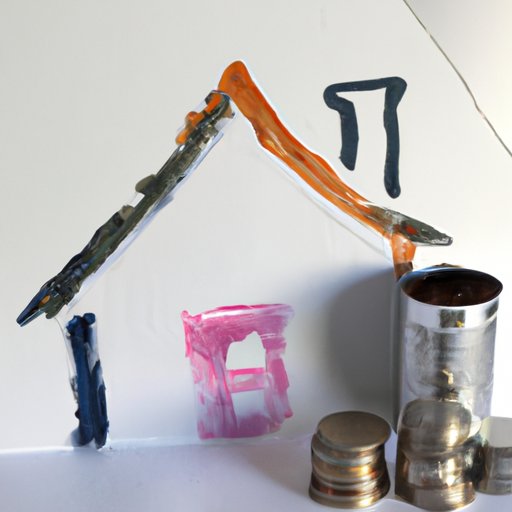Introduction
When it comes to beautifying your home, painting is one of the most popular options. A fresh coat of paint can give your house a new look, increase its value, and protect it from wear and tear. However, painting a house can also be a significant investment. In this article, we will discuss the different factors that affect the cost of house painting, the pros and cons of DIY vs. hiring professionals, and ways to save money without compromising quality. Whether you are planning a small touch-up or a major renovation, this guide will help you navigate the world of house painting costs.
Painting Your Home: Factors That Affect the Cost
Several factors contribute to the total cost of painting a house, such as the size of the house, the type of paint, the prep work needed, and the labor costs of the painting contractor. The larger the house, the more paint and labor will be required, which can affect the final cost. The type of paint used can also impact the cost; high-quality paint can cost more but may last longer and provide better coverage. Prepping the house, including washing, scraping, and sanding the surface, can also affect the cost. The more prep work needed, the more it will cost to paint the house. Labor costs also vary depending on the painting contractor’s experience and the region of the country where you live.
DIY vs. Professional House Painting: Which Option is More Cost-Effective?
When considering house painting costs, you must decide whether to do it yourself or hire professionals. While DIY painting can save you money, it also requires time and effort. It may also be challenging to achieve the desired results, particularly for those with limited painting experience. Professional painting companies may be more expensive, but they have the necessary skills and equipment to handle any painting project with ease. They also provide warranties and guarantees for their work, which can give you peace of mind.
Unexpected Costs of House Painting: Don’t Forget These Expenses
Many homeowners fail to budget for other expenses that can arise during a house painting project. Equipment rentals, permits, additional repairs, and other fees can add to the total cost of the project. Depending on the age and condition of your home, you may encounter unexpected repairs that need fixing before painting can begin. It’s essential to plan for these potential expenses to avoid any financial surprises.
A Breakdown of Average Costs for House Painting Across the US
The average cost of house painting varies widely depending on your region’s location. According to industry surveys, the average cost of painting a house ranges from $1,500 to $8,000, with the national average cost being $2,580. In general, the East and West coasts were found to be the most expensive regions, while the Midwest and South were more affordable. Keep in mind that prices may vary based on other factors, such as the scope of the project, the level of prep work required, and the quality of the paint.
How to Save Money on House Painting Without Compromising Quality
If you’re looking for ways to save money on your house painting project without sacrificing quality, there are several things you can do. One tip is to find affordable painters by comparing quotes from different contractors and negotiating prices. Choosing the right materials, such as high-quality paint, can also save you money in the long run. Doing some of the prep work yourself, such as sanding and cleaning, can also reduce labor costs.
Is it Worth it to Paint Your Own Home? We Analyze the Costs
If you’re considering painting your house yourself, it’s essential to weigh the costs and benefits carefully. While DIY painting can save you money, it can also be time-consuming and challenging. Other expenses, such as equipment rentals and the potential for mistakes, can add to the total cost of the project. If you’re confident in your painting skills and have the necessary equipment and know-how, painting your own house can be a satisfying and budget-friendly option.
Conclusion
House painting can be a significant investment, but it’s also an excellent way to enhance your home’s appearance and value. By understanding the different factors that affect the cost of house painting, comparing DIY vs. professional options, and taking steps to save money without compromising quality, you can make an informed decision that works best for your budget and needs. Whether you decide to do it yourself or hire professionals, remember to plan for unexpected expenses and enjoy the process of transforming your home into a beautiful new space.
(Note: Is this article not meeting your expectations? Do you have knowledge or insights to share? Unlock new opportunities and expand your reach by joining our authors team. Click Registration to join us and share your expertise with our readers.)
